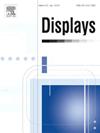A halo effect measurement for transparent micro-LED display under simulation
IF 3.4
2区 工程技术
Q1 COMPUTER SCIENCE, HARDWARE & ARCHITECTURE
引用次数: 0
Abstract
Halo effects, characterized by luminous rings or diffuse light surrounding bright objects on a screen, are influenced by factors such as display technology, ambient lighting conditions, and the human visual system. These effects can degrade image quality, reduce contrast, and impair the accuracy of visual tasks, making them a critical area of investigation in both academia and industry. Current halo measurement methods mainly focus on the mini-LED partition backlit liquid crystal displays (LCDs) and are nearly all physical-based, limiting their application and generalization ability. In this paper, we propose a simulation-based halo measurement framework, which offers a more flexible evaluation scheme with scene-fused halo generation. Specifically, we first simulate the four existing categories of halo manifestation externally through code, i.e., regular ring-shaped halo, rectangular halo, irregular content-dependent halo, and localized surrounding halo. Then, we build a 3D indoor environment to simulate the laboratory measurement environment, where a micro-LED-based display with variable parameters is taken as the evaluation object. To demonstrate the usefulness of this new and unique halo measurement resource, we conduct both subjective and objective experiments. The high subjective and objective consistency achieved by a simple deep learning-based image quality assessment (IQA) model demonstrates its utility that broadens the scene limits of display design.
基于仿真的透明微型led显示屏光晕效应测量方法
光晕效应的特征是屏幕上明亮物体周围的发光环或漫射光,受显示技术、环境照明条件和人类视觉系统等因素的影响。这些效应会降低图像质量、降低对比度并影响视觉任务的准确性,因此成为学术界和工业界研究的一个重要领域。目前的光晕测量方法主要集中在微型 LED 分区背光液晶显示器 (LCD),几乎都是基于物理方法,限制了其应用和推广能力。在本文中,我们提出了一种基于模拟的光晕测量框架,它通过场景融合光晕生成提供了一种更灵活的评估方案。具体来说,我们首先通过代码从外部模拟现有的四类光环表现形式,即规则环形光环、矩形光环、不规则内容光环和局部周围光环。然后,我们构建了一个三维室内环境来模拟实验室测量环境,并以参数可变的微型 LED 显示器作为评估对象。为了证明这种新颖独特的光晕测量资源的实用性,我们进行了主观和客观实验。基于深度学习的简单图像质量评估(IQA)模型实现了高度的主观和客观一致性,证明了它的实用性,拓宽了显示屏设计的场景限制。
本文章由计算机程序翻译,如有差异,请以英文原文为准。
求助全文
约1分钟内获得全文
求助全文
来源期刊

Displays
工程技术-工程:电子与电气
CiteScore
4.60
自引率
25.60%
发文量
138
审稿时长
92 days
期刊介绍:
Displays is the international journal covering the research and development of display technology, its effective presentation and perception of information, and applications and systems including display-human interface.
Technical papers on practical developments in Displays technology provide an effective channel to promote greater understanding and cross-fertilization across the diverse disciplines of the Displays community. Original research papers solving ergonomics issues at the display-human interface advance effective presentation of information. Tutorial papers covering fundamentals intended for display technologies and human factor engineers new to the field will also occasionally featured.
 求助内容:
求助内容: 应助结果提醒方式:
应助结果提醒方式:


